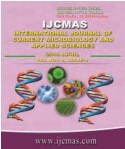


 National Academy of Agricultural Sciences (NAAS)
National Academy of Agricultural Sciences (NAAS)

|
PRINT ISSN : 2319-7692
Online ISSN : 2319-7706 Issues : 12 per year Publisher : Excellent Publishers Email : editorijcmas@gmail.com / submit@ijcmas.com Editor-in-chief: Dr.M.Prakash Index Copernicus ICV 2018: 95.39 NAAS RATING 2020: 5.38 |
Considering nutraceutical potentiality of phytochemicals, a few indigenous red rice germplsams of Assam, India were analysed for various phytochemicals, antioxidant activities and a few mineral contents. Among the sixteen germplasm analysed in their brown form, the total phenol content, total flavonoid content, and the anthocyanin content per100 gm dry matter ranged from752.89 mg±18.12 (‘Ranga Dariya’) to 2223 mg±33.48 (‘Amana Bao’), 252.12±15.40mg (‘Ixojoy’) to 1000.75±86.93mg (‘Dal Bao’) and 76.05± 0.32 µg (‘Kolaguni’) to159.42±15.97 µg (‘Betu’), respectively. For the polished form of rice, the same in 100 gm dry matter ranged from76.51 mg±1.46 in ‘Ranga Dariya’ to 1409 mg±100.88 in ‘Kolaguni’, from 32.09± 7.17 mg in ‘Ranga Dariya’ to 374.46± 2.05mg in ‘Negheribao’ and from 17.91±5.08µg (‘Biroi’) to 115.42±11.72µg (‘Hurupibao’), respectively. The antioxidant activities were observed to be the highest 96.00±0.26% in ‘Negheribao’ (for brown form of rice) and 86.35± 3.88% in ‘Kenekuabao’ (for polished form of rice) and the lowest 81.54±0.23% in ‘Betu’(for brown form of rice) and 59.65±4.64 % in ‘Ranga Dariya’ (polished rice), respectively. In brown rice, on dry weight basis, the iron, zinc and manganese content ranged from 2.12-54.40 mg per 100 gm, 2.42 mg to 26.57mg per 100 gm and 0.04 mg per 100 gm to 25.13 mg per 100 gm, respectively. The study revealed some indigenous rice germplasm of Assam, India which are significant considering phenolic compounds and mineral content.
 |
 |
 |
 |
 |